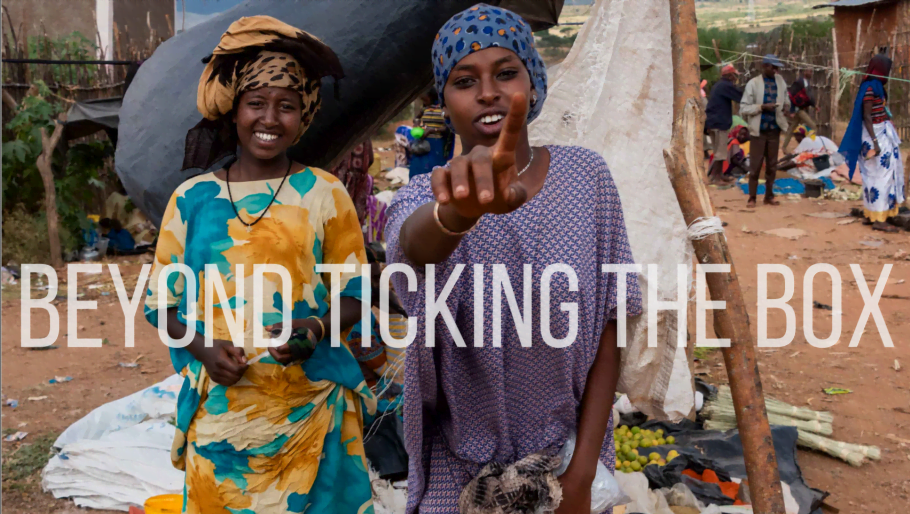Cash actors have the power to mitigate GBV – here are six ways to do it
Cash actors play an important role in providing assistance that helps to save lives and increases resilience. But it’s also our responsibility to carefully consider any possible Gender-Based Violence (GBV) risks that cash and voucher assistance (CVA) could create for women* who receive it. While there has been great progress in recent years to improve women’s safety when accessing CVA, it’s time to go the extra mile. This year to mark the ‘16 days of activism on Gender Based Violence’ we’re recommending some easy ways to implement GBV risk mitigation measures throughout the CVA program cycle.

Why include GBV risk mitigation in CVA?
Humanitarian actors have been working to integrate gender, GBV and inclusion in a meaningful and concrete way into CVA. Teams are working hard to engage with communities, be accountable to vulnerable populations, strengthen community feedback and communication channels, and adapt CVA delivery mechanisms to be as safe as possible for recipients.
Cash actors have been at the forefront of innovative solutions to deliver assistance in extremely challenging places. It’s now time for us to be at the forefront of GBV risk mitigation, as well.
Collective responsibility is the theme of this year’s 16 Days of Activism. It is an important reminder that we all have an obligation to work to mitigate GBV in our own work. Let’s talk about how you can play your part – today, throughout the rest of the 16 Days of Activism and all year long.
Don’t be scared! 6 easy steps to mainstream GBV risk mitigation
Luckily, mainstreaming GBV risk mitigation is easier than it may seem.
Here are six straightforward ways to integrate GBV risk mitigation into your own CVA programming.
1- Train your team on basic GBV / PSEA principles and ensure that they’ve signed a Code of Conduct
Train everyone on your team about the basic principles of preventing sexual exploitation and abuse (PSEA) and GBV. Make sure after the training that everyone involved in the CVA intervention signs a Code of Conduct committing them to the highest standards of personal and professional conduct during the CVA response including financial services providers.
2- Map existing GBV risks
Identify GBV risks and potential types of GBV in your context. It’s also important to identify any existing mitigation measures from people, the community, or humanitarian actors active in the context. GBV risks may be related to participation and inclusion, safe and dignified access, confidentiality of GBV survivors’ data, social norms, and partner, household, and community relations. Need inspiration? There are examples from many countries that have done just this already.
3- Talk to women CVA recipients and GBV/protection experts
Have conversations with women and other key populations to help identify potential protection, gender, and GBV risks related to CVA in their contexts and potential mitigation measures for those risks. For example, these conversations can help to identify physical places such as distribution points and markets where women may feel unsafe or be at risk of violence.
4- Make sure there are female frontliners in your CVA response
It’s vital to have female staff at the frontline of any CVA. Doing so lessens the risk of abuse and exploitation of women receiving the assistance. It can help people who identify as women to feel more comfortable reporting any complaints or personal issues regarding CVA.
5- Revisit your PDM questions and how you analyse them
Add questions to your post-distribution monitoring (PDM) that specifically ask CVA recipients about any GBV-related challenges they face when receiving the assistance. For instance, enumerators can ask questions about the behaviour of staff or recipients’ feelings of safety when receiving CVA. Equally important is to make sure to analyse the responses of women and men separately.
6- Ensure your Complaint and Feedback Mechanism is available for women and at-risk groups
Complaint and Feedback Mechanisms are a key way to identify and respond to the concerns of women, acting as an early warning system of cases of sexual exploitation and abuse and to identify cases of other forms of GBV and offer support to survivors of it. Make sure that your Complaint and Feedback Mechanism is readily available for use by making it as easy to access as possible – especially striving to mitigate any cultural, language, social, or physical barriers – and offering multiple ways for beneficiaries to report any potential issues with the CVA process.
Want to know more?
These steps are all outlined and further explained in the GBV Risk Mitigation in CVA Toolkit. The Toolkit is a bottom-up effort by UNFPA and the GBV Area of Responsibility (AoR) meant to guide and support CVA and GBV practitioners in identifying and mitigating potential GBV risks in CVA. It features nine easy-to-use and field-oriented tools jointly drafted with CVA and GBV experts that can enhance the accountability of CVA programming and work to create even better results.
Included in the Toolkit are a number of examples of best practices from the field in Iraq, Ukraine, Moldova, Somalia, and Burundi. These examples showcase the important collaborations between CVA and GBV actors to concretely and pragmatically mainstream GBV risk analysis.
Just like the 16 Days remind us, it’s our collective responsibility to end GBV – let’s make sure that cash actors are at the forefront of this effort!
Endnote
* Please note that while women and girls are the main victims of GBV, men, boys and individuals with fluid gender identities can also be at risk of and affected by GBV. While this blog refers mainly to women for the sake of brevity, please bear in mind that it is important to focus on GBV risk mitigation for all persons at risk of GBV regardless of gender.
Bio of Authors

Madeline Dement is UNFPA’s CVA Global Initiatives Support Assistant. She supports the creation, organisation, sharing, and use of CVA knowledge at UNFPA as well as the organisation’s CVA capacity development initiatives.

Luana de Souza-Monbaron is a Roving CVA & GBV Specialist from UNFPA/GBV AoR. In the past years, she has provided technical support to CVA and GBV field experts with regards to GBV risk mitigation in CVA in various contexts.


